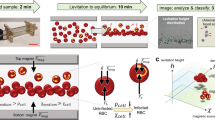Summary
After aggregation of erythrocytes from malaria infected mice, the parasites (Plasmodium vinckei) could be set free using gentle mechanical forces. The mixture of freed parasites, infected and non-infected erythrocytes, and membraneous material was separated by free-flow electrophoresis. The free parasites produced were very pure and infectious. Morphological and enzymatic data on the separated fractions are presented. Free-flow electrophoresis also allowed the separation of infected and uninfected erythrocytes.
Similar content being viewed by others
References
Hannig, K., Heidrich, H.-G.: The use of continuous preparative free-flow electrophoresis for dissociating cell fractions and isolation of membraneous components. Methods Enzymol.31, 746–761 (1974)
Heidrich, H.-G.: Isolation of pure inner and outer mitochondrial membranes in preparative scale using a new technique. In: Advances in automated chemistry. Proceedings of the Technicon International Congress 1969, Vol. 1, pp. 347–350. 1970
Heinzel, W., Vogt, A., Kallee, E., Faller, W.: A new method for the quantitative determination of antibody and antigen protein with a sensitivity to five micrograms. J. Lab. Clin. Med.66, 334–343 (1965)
Kreier, J.P.: The isolation and fractionation of malaria-infected cells. Bull. WHO55, 317–331 (1977)
Lewis, S.M., Osborn, J.S., Stuart, P.R., Williams, J.: Internal architecture of malaria-infected red cells as revealed by ion etching and scanning electron microscopy. Trans. R. Soc. Trop. Med. Hyg.63, 418–426 (1969)
Picard-Maureau, A., Hempelmann, E., Krämmer, G., Jackisch, R., Jung, A.: Glutathionstatus inPlasmodium vinckei parasitierten Erythrozyten in Abhängigkeit vom intraerythrozytären Entwicklungsstadium des Parasiten. Z. Tropenmed. Parasitol.26, 405–416 (1975)
Rock, R.C., Standefer, J.C., Cook, R.T., Little, W., Printz, H.: Lipid composition ofPlasmodium knowlesi membranes: comparison of parasites and microsomal subfractions with host rhesus erythrocyte membranes. Comp. Biochem. Physiol. [B]38, 425–437 (1971)
Rüssmann, L.: Diplomarbeit, Universität Tübingen, Fachbereich Chemie-Biochemie (1978)
Schnaitman, C., Greenawalt, J.W.: Enzymatic properties of the inner and the outer membranes of rat liver mitochondria. J. Cell Biol.38, 158–175 (1968)
Seed, Th., Kreier, J.P.: Surface properties of extracellular malaria parasites: electrophoretic and lectin-binding characteristics. Infect. Immun.14, 1339–1347 (1976)
Trager, W., Jensen, J.B.: Cultivation of malarial parasites. Nature273, 621–622 (1978)
Author information
Authors and Affiliations
Rights and permissions
About this article
Cite this article
Heidrich, HG., Rüssmann, L., Bayer, B. et al. Free-flow electrophoresis for the separation of malaria infected and uninfected mouse erythrocytes and for the isolation of free parasites (Plasmodium vinckei): A new rapid technique for the liberation of malaria parasites from their host cells. Z. Parasitenkd. 58, 151–159 (1979). https://doi.org/10.1007/BF01951339
Received:
Issue Date:
DOI: https://doi.org/10.1007/BF01951339




